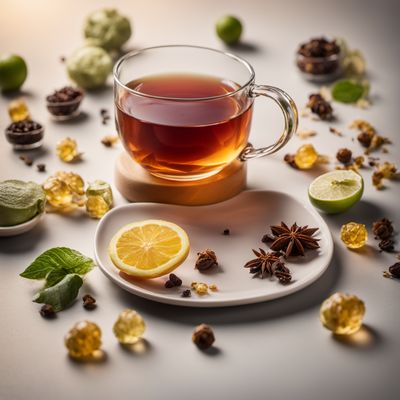
Ingredient
Tea, decaffeinated, infusion
The Soothing Elixir: Decaffeinated Tea Infusion
Decaffeinated tea infusion is made from tea leaves that have undergone a process to remove most of the caffeine content while preserving the natural flavors and aromas. It is available in various tea varieties, including black, green, and herbal teas. The taste and aroma of decaffeinated tea infusion can vary depending on the specific tea type and the processing method used. It is often described as smooth, mellow, and refreshing, making it a popular choice for those seeking a caffeine-free tea experience.
Origins and history
The history of decaffeinated tea dates back to the early 20th century when a German merchant named Ludwig Roselius developed a method to remove caffeine from tea leaves. Since then, various methods have been developed to decaffeinate tea, including the use of solvents, carbon dioxide, or water. Decaffeinated tea has gained popularity among individuals who are sensitive to caffeine or prefer to limit their caffeine intake. It offers a way to enjoy the flavors and benefits of tea without the stimulating effects of caffeine.
Nutritional information
Decaffeinated tea infusion provides a range of health benefits similar to those of regular tea, including antioxidants and polyphenols that support overall well-being. It is also a hydrating beverage that can contribute to daily fluid intake. However, it is important to note that decaffeinated tea may still contain trace amounts of caffeine, although significantly less than regular tea. The exact caffeine content can vary depending on the specific tea type and the decaffeination process used.
How to select
When selecting decaffeinated tea, look for reputable brands that use high-quality tea leaves and follow proper decaffeination methods. Check the packaging for information on the specific tea type and the decaffeination process used. It is also advisable to choose organic or pesticide-free options to minimize exposure to potentially harmful substances. Additionally, consider your personal taste preferences and choose a tea variety that suits your palate.
Storage recommendations
To maintain the freshness and quality of decaffeinated tea, it is best to store it in an airtight container away from moisture, heat, and light. Avoid storing it near strong-smelling substances, as tea can absorb odors easily. It is recommended to consume decaffeinated tea within a reasonable timeframe to enjoy its optimal flavor and aroma.
How to produce
Decaffeinated tea can be produced using various methods, including solvent-based processes, carbon dioxide extraction, or water-based methods. These processes involve removing caffeine from the tea leaves while preserving the natural flavors and aromas. It is important to note that decaffeinated tea may still contain trace amounts of caffeine, although significantly less than regular tea. The specific production method can vary depending on the tea type and the manufacturer.
Preparation tips
To prepare decaffeinated tea infusion, start by boiling fresh water and allowing it to cool slightly. Place the decaffeinated tea bag or loose tea leaves in a teapot or a cup, and pour the hot water over them. Steep the tea for the recommended time, usually 3-5 minutes, or according to the instructions provided. Remove the tea bag or strain the tea leaves, and enjoy the soothing and flavorful infusion. Add sweeteners or other ingredients according to personal preference.
Culinary uses
Decaffeinated tea infusion can be enjoyed on its own or with added sweeteners, such as honey or sugar. It can be served hot or cold, depending on personal preference. Decaffeinated black tea is often used as a base for iced tea or blended with other ingredients to create flavorful tea blends. Decaffeinated green tea is commonly enjoyed as a soothing and refreshing beverage. Herbal teas, such as chamomile or peppermint, are popular choices for relaxation and promoting a sense of calm.
Availability
Worldwide


